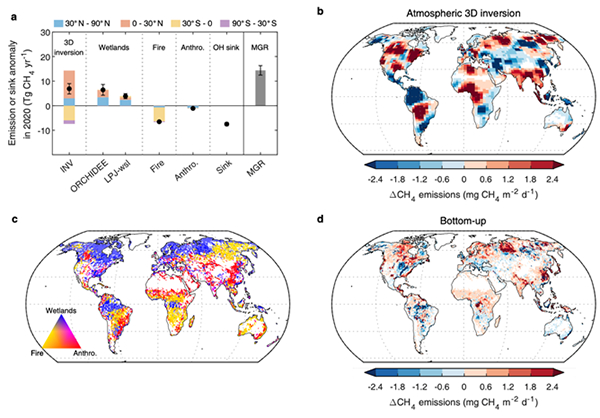
Figure. The attribution of the surge of atmospheric methane in 2020.
(a) Methane emissions and sink anomaly in 2020 relative to 2019. (b) Spatial pattern of emissions anomaly from top-down inversions. (c) Spatial distribution of contribution sources (wetlands, fire and anthropogenic) to change in emissions derived from bottom-up estimates. (d) Spatial pattern of emissions anomaly from bottom-up estimates including wetland, fire and anthropogenic emissions.
Supported by the National Natural Science Foundation of China (Grant No. 41722101 and 41830643), the research team led by Prof. Shushi Peng from Peking University, in collaboration with international scholars, has made progress in the study of the mechanism of atmospheric methane concentration growth rate. The research results were published in Nature on December 15, 2022, titled “Wetland emission and atmospheric sink changes explain methane growth in 2020”.
Article link: http://www.nature.com/articles/s41586-022-05447-w.
Methane is a powerful greenhouse gas. Its atmospheric concentration has increased by a factor of two during the Anthropocene. Cutting human-caused methane emissions is an urgent priority to keep climate warming to well below 2°C, the target of the Paris Agreement. Remarkably, the growth rate of atmospheric methane has been increasing in the past 15 years, and in the year 2020, reached the highest growth rate since atmospheric measurements started in the early 1980s. Thus, why the growth rate of atmospheric methane has been increasing recently is an incredibly challenging puzzle.
The growth rate of atmospheric methane concentration is controlled by anthropogenic emissions, natural emissions and atmospheric methane sink. However, large uncertainties in both emissions and sinks disrupt the attribution of recent surge of atmospheric methane. In 2020, the atmospheric methane level showed an enigmatic surge, although worldwide COVID-19 lockdown could likely decrease anthropogenic methane emissions. This very special year is a real-world ‘natural experiment’ that provided us with insights about the recent surge of atmospheric methane.
To solve the methane enigmatic mystery, Prof. Shushi Peng and overseas collaborators, combined bottom-up inventories and top-down inversions with “big” data of methane emissions and sinks, and elucidated the cause of the 2020 surge in atmospheric methane. The results show higher wetland emissions due to warmer and wetter climate in the Northern Hemisphere, contributing half of the 2020 surge in atmospheric methane. Lower anthropogenic nitrogen oxide (NOx) emissions during COVID-19 lockdown in 2020 decreased hydroxyl radical (OH) concentration, which explains another half of the 2020 surge in atmospheric methane (Figure). This highlights and warns that future anthropogenic pollution emissions (NOx etc.) that indirectly change lifetime of atmospheric methane should be taken into account in future methane emissions-cutting plans.
This study provides new insights for global methane budget, and offers new scientific evidence for Global Methane Pledge and achieving the warming target of the Paris Agreement. Prof. George H. Allen applauded this study in the commentary article published in the same issue, entitled “Cause of the 2020 surge in atmospheric methane clarified”. (http://www.nature.com/articles/d41586-022-04352-6).

Add: 83 Shuangqing Rd., Haidian District, Beijing, China
Postcode: 100085
Tel: 86-10-62327001
Fax: 86-10-62327004
E-mail: bic@donnasnhdiary.org
京ICP备05002826号 文保网安备1101080035号 Copyright 2017 NSFC, All Right Reserved